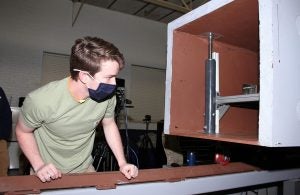ECU blast simulator provides opportunities for research

Parker Zieg, a senior engineering major, looks inside the blast simulator to check results from a test. (ECU photos by Ken Buday)
John Benson puts in ear plugs and steps back.
Five seconds, 10 seconds and then — BANG. Air bursts through a mylar film membrane and slams through the test chamber of the East Carolina University Advanced Blast Wave Simulator.
“I enjoy it,” said Benson, an engineering major. “We have 5 millimeter thick membrane, but we also have 10 millimeter membrane and that actually takes roughly 30 seconds to charge before it bursts. You can feel that one when it goes off.”
As fun as it may be, serious work is taking place at the simulator in a normal-looking building on North Greene Street in Greenville.
“The ECU-ABWS is used to produce blast waves of various profiles and intensities, which can be used to study the impacts of blast on various objects such as aircraft, UAVs, bridges, vehicles and building structures,” said Dr. Yang Liu, assistant professor in the Department of Engineering.
The simulator is a long, rectangular box divided into two main sections. Pressurized air or nitrogen builds to a maximum of 16 pounds per square inch. The opening of a control valve sends that gas into the pressure driver section. It pushes against a membrane that then breaks under the pressure.
“The sudden energy release caused by the rupture of the membrane results in a blast wave being sent through the test section,” Liu said.

Dr. Yang Liu, second from right, an assistant professor in the Department of Engineering, talks to students next to the blast simulator.
On this particular day, lead student researcher Parker Zieg, fellow student Ronaldo Moreno-Antonio, Benson and Liu conduct experiments using a high-speed Schlieren imaging system and a multipoint pressure senor system to visualize and quantify the blast waves under various burst pressures. They view the results on a computer.
“This is the very first time that we can ‘see’ the inside blast wave propagation in the ECU-ABWS,” Liu said.
Benson said that working with the ABWS fits into his planned specialty of thermodynamics and fluid flow.
“There is a lot of energy transfer, and just the way the air flows over items when it’s super compressed into that blast wave, it’s pretty interesting to me and provides some good work experience in fluid analytics that I can take into the field later,” he said.
The testing being done now will lead to research on UAVs with the use of Liu’s start-up funds from the ECU Division of Research, Economic Development and Engagement.

Dr. Yang Liu discusses a test in the blast simulator with students.
“For the moment, we are testing the impacts of blasts on UAV aerodynamic properties,” Liu said “The accomplishment of this study will provide very important guidelines in developing blast mitigation technologies for UAVs.”
The ABWS has been at ECU since 2014, and Liu sees a positive future. He said multiple grant proposals are in the works, and he hopes to collaborate with more faculty members from various disciplines moving forward.
“We hope to set up a series of advanced thermal flow diagnostic systems to help us better understand the blast waves and their impacts on various objects,” he said. “The ECU-ABWS will not only be used in research projects, but also be developed into an advanced experimental platform for various teaching laboratories for both undergraduate and graduate classes.”
— By Ken Buday